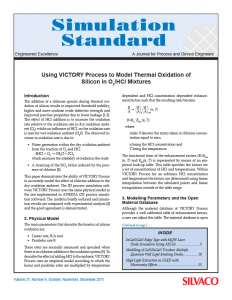Using VICTORY Process to Model Thermal Oxidation of Silicon in O2/HCl Mixtures
Introduction
The addition of a chlorine species during thermal oxidation of silicon results in improved threshold stability, higher and more uniform oxide dielectric strength and improved junction properties due to lower leakage [1-3]. The effect of HCl addition is to increase the oxidation rate relative to the oxidation rate in dry oxidation ambient (O2), whilst no influence of HCL on the oxidation rate is seen for wet oxidation ambient (H20). The observed increase in oxidation rate is due to:
- Water generation within the dry oxidation ambient from the reaction of O2 and HCl
4HCl + O2 ? 2H2O + 2Cl2
which increases the solubility of oxidant in the oxide - A straining of the SiO2 lattice induced by the presence of chlorine [4].
This paper demonstrates the ability of VICTORY Process to accurately model the effect of chlorine addition to the dry oxidation ambient. The 3D process simulation software VICTORY Process uses the same physical model as the one implemented in ATHENA (2D process simulation software). The model is briefly outlined and simulation results are compared with experimental analysis [4] and the good agreement is demonstrated.



